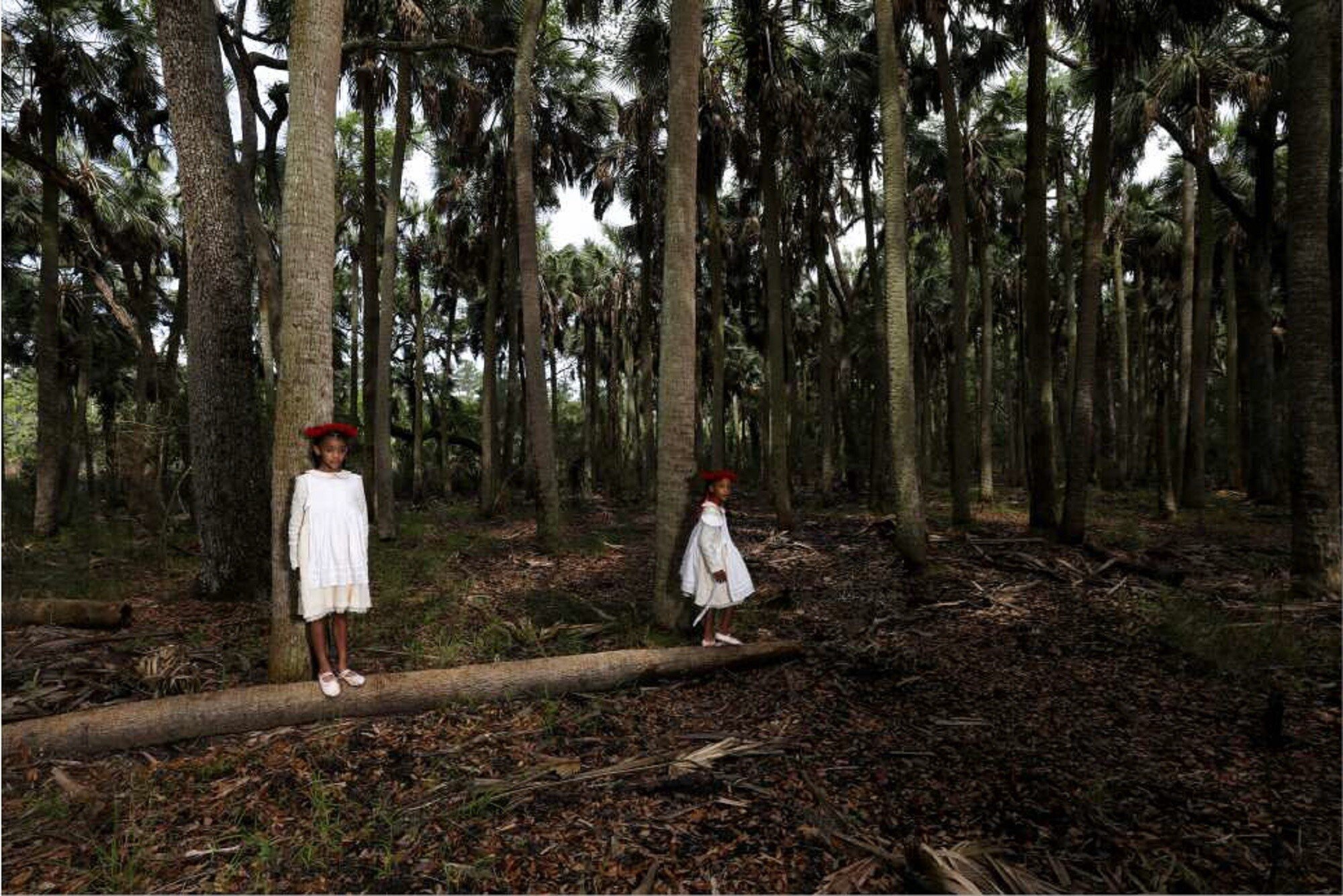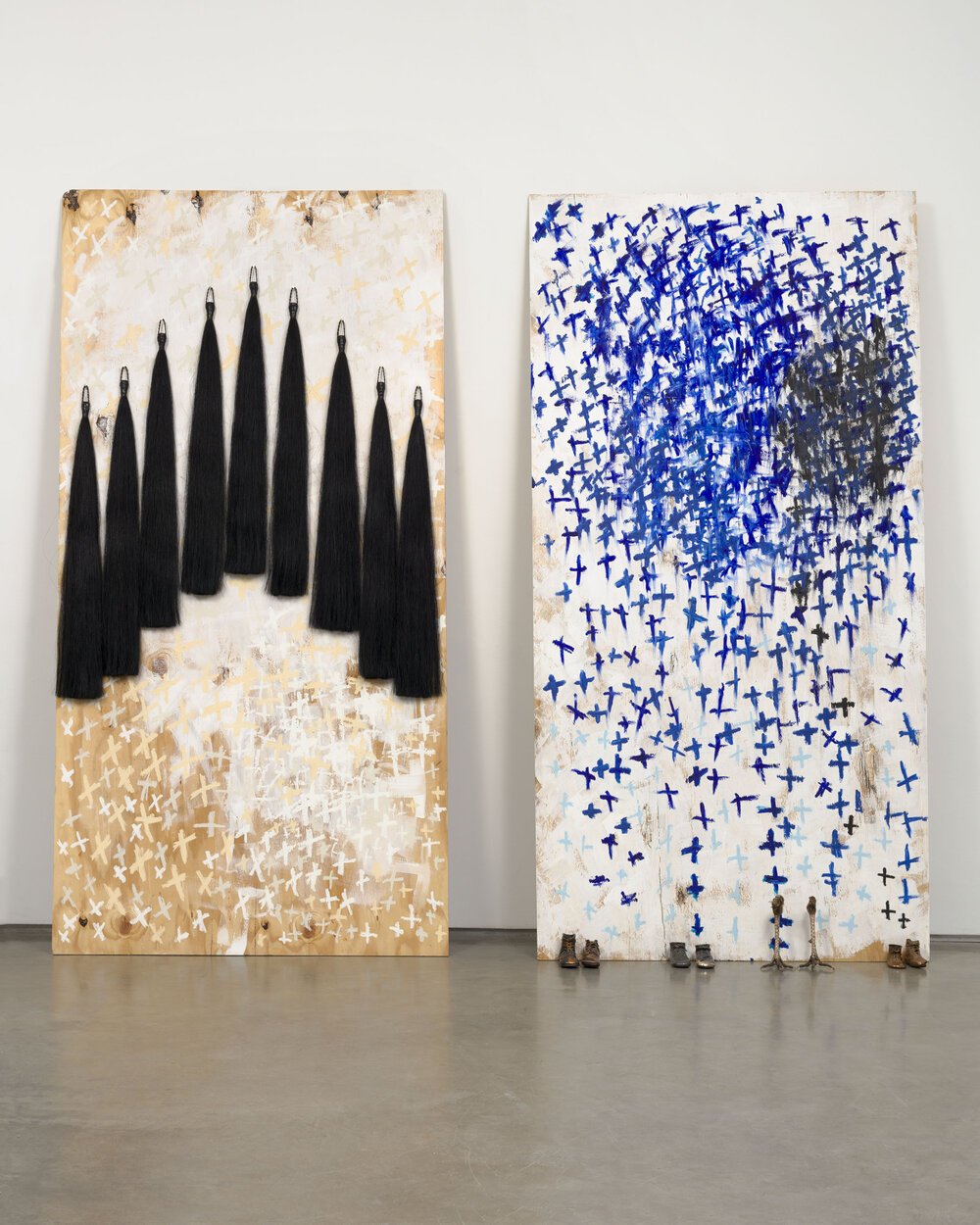Allison Janae Hamilton: MOOD
Sisters, Wakulla County, FL, (2019)
My first interaction with Hamilton’s work was when I visited the Studio Museum in Harlem the last day they were open in their previous space. Her instillation, Foresta filled a nook with elegant taxidermy, tambourines and haunting stick figures in conversation with a video work that transported me to another place, home. As a southern black history buff, that has a personal connection to many of the landscapes in Hamiltons work, it deeply resonates with me.
Foresta , (installation view) Installed at the Studio Museum in Harlem, (September 2017 - January 2018).
Allison Janae Hamilton’s work grapples with how historic moments, often forgotten affect the present, Hamilton says “I am trying to situate today in a longer context, in a continuum” and does this by creating powerful testaments for voices that were ignored in the past and have continued to be so today.
For her installation in MOOD, the Studio Museum’s Residency program (housed at Moma PS1 in 2019) Hamilton created videos, sculptures, and photographs that entangled variations of freedom, spirituality, and community. Walking down the hall on the installation floor, the sound of rushing water called me towards a corridor marked by platinum-painted sable palm frond sculptures “Metal Yard Sign with Sabal Palm Fronds I” (2019) and “Metal Yard Sign with Sabal Palm Fronds II” (2019). Reminiscent of the scrap metal sculptures, wooden signs, and other objects of communication winding through the southern backroads. The room was filled with prismatic earthy tones caused by the short film showing the Wacissa River. This transportation to the bed of the river was almost meditative until the movement of the seagrass and broken remnants became more visceral leading to an anxious state. “Wacissa” (2019) was filmed in the Slave Canal, dug by slaves in the 1850s to bridge the Wacissa and Aucilla rivers to ease the transport of cotton, which became obsolete before its completion with the introduction of the railroad. The Slave Canal is now famed for its uncorrupted natural beauty.
Wacissa, Single-channel video., (2019). Blackwater Creature IV (2019).
The iconography of the physical and spiritual of this landscape by its often-forgotten people continued in Hamilton's solo and group installations. Photos of women floating in emerald water diffused by light wearing gauzy white gowns “Florida Watconnectionser I” (2019) and “Florida Water II” (2019), aligned with the regional practice of blending traditions from ancestral spirituality and introduced Christian practices. In Hoodoo, Vodou, and Santeria practices, Florida Water is often used in rituals, ceremonies, and offerings. The White dress continued to be present in other images. While The white dresses in Florida Water I and II were more representative of ceremonial practices, in “Sabal Palm Forest Sisters, Wakulla County, FL” (2019) and “Three Girls in Sabal Palm Forest II” (2019) the young girls in the mischievous exploration of the forest felt more symbolic of white clothing as the mark of spiritual guides in the community.
Florida Water I (2019)
“Blackwater Creature I” (2019) a mass of various pale objects, including horsehair hung towards the back of the room. Its purpose was to bring viewers to think abstractly about the trees and nature's witness to “the fossilization of time”. Continuing the conversation on time, in “Yard Sign with Yellow and White Constellation” (2019), “Yard Sign with Blue Constellation (2019)” and “Yard Sign with White Feather”(2019) Hamilton notes the importance of the time for gathering. The wooden yard signs and sculptures ornamented with clay, feathers, abstract constellations, horsetails, bronze shoes and more are sharing the stories of the turpentine workers. Hamilton shared a quote from one stating “Any moments of leisure were under the cover of the night sky”.
(Far left) Yard Sign with Yellow and White Constellation(2019), (Left)Yard Sign with Blue Constellation,( 2019) (Right) Yard Sign with White Feathers, (2019)
Allison Janae Hamilton's work is vital preservation of history wiped away by force and nature. She speaks to culture often misunderstood and forgotten, reminding us that “People think of the South as the past, but the South is today”.
Further Explorations: Ja’Tovia Gary, Danh Vo, Jack Whitten, Betye Saar, Felix GonzolasTorres
Amber D. Smith, Aug 2019




